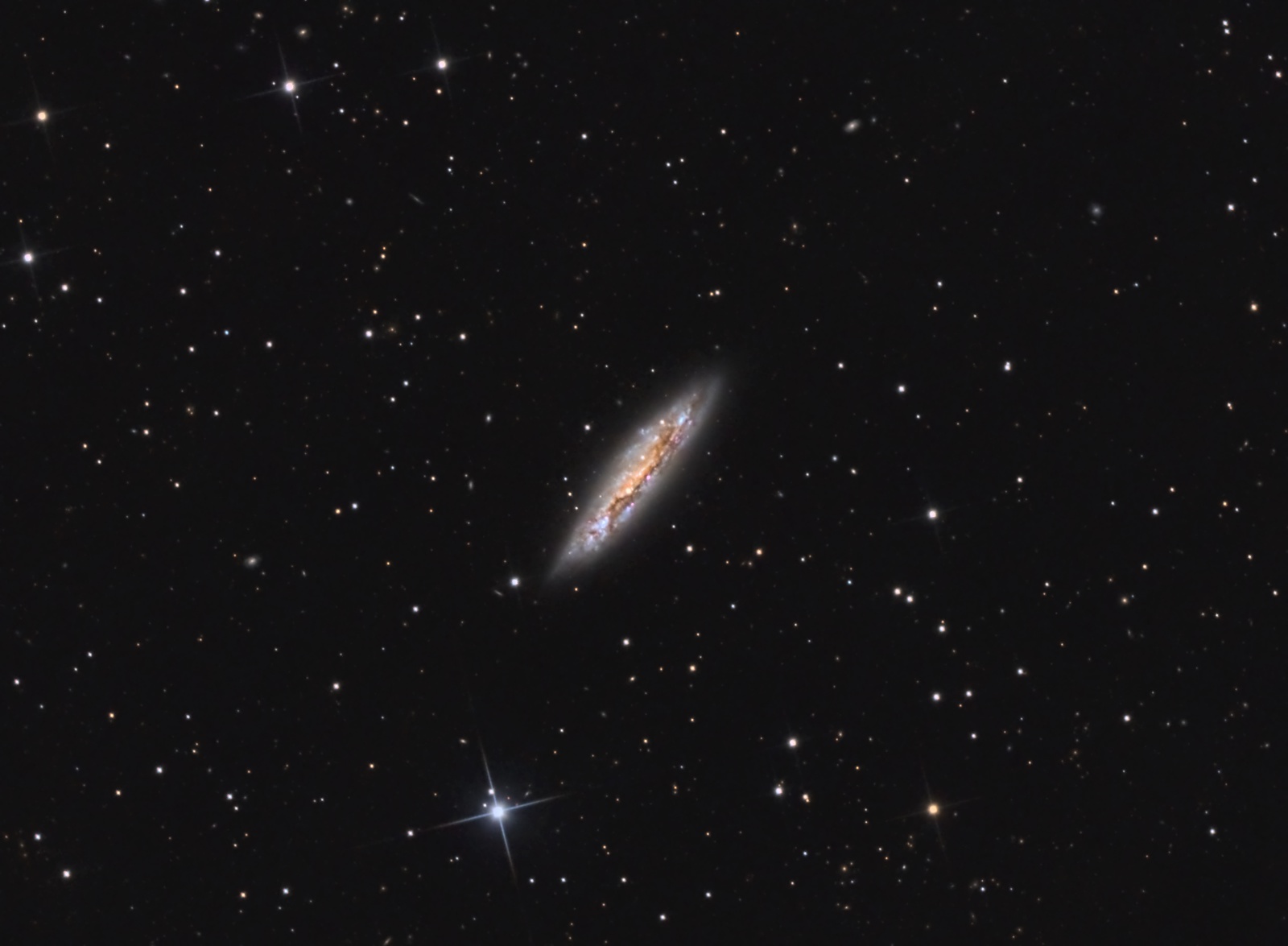M108, Barred Spiral Galaxy
 Click image for full size version
Click image for full size version
February 19, 2019
M108 is a barred spiral galaxy in Ursa Major, near Merak, the lower-right star of the Big Dipper’s bowl. It lies about 46 million light years away. M108 belongs to the Ursa Major galaxy cluster, which in turn is a member of the Virgo Supercluster of galaxies. This image includes dozens of galaxies that lie much further away than M108. Look for streaks and smudges that look different from the sharper stars.
This very active galaxy displays the full range of colours found in some spiral galaxies, including pink nebula, blue star clusters, a yellow/orange core and many dark brown dust lanes throughout. The super-massive black hole at the centre of M108 has a mass about 24 million times the Sun’s.
I processed this image data previously, but much prefer the current result. The colours in the current version seem more natural to me and the faint, extended parts of the galaxy are better revealed in the current image.
Tekkies:
SBIG STL-11000M camera, Astrodon LRGB and Baader Ha filters, 10″ f/6.8 ASA astrograph, Paramount MX. Guided with STL-11000’s external guider and 80 mm f/6 Stellarvue refractor. Acquistion, guiding and calibration with Maxim-DL. Focusing with FocusMax. Automation with CCDCommander. Registration, integration and processing in PixInsight. Shot from my SkyShed in Guelph, Ontario. Moderate moonlight for RGB, no moon for L; gibbous to full moon for Ha. Acquired March 2015.
11x10m R, 9x10m G, 11x10m B and 41x10m L unbinned frames (total=12hr).
Image scale is about 1.1 arcsec per pixel for this camera / telescope combination.
Data Reduction and Cleanup
The BatchPreProcessing script was used to calibrate, cosmetically correct and register all subframes. ImageIntegration was used to make the L, R, G and B masters. DynamicCrop was used to crop all the masters identically. DynamicBackgroundExtraction was applied to each master in Subtraction mode.
RGB
Creation and cleanup: The R, G and B masters were combined with ChannelCombination to make an RGB image which was processed with PhotometricColorCalibration.
Linear Noise Reduction: MultiscaleLinearTransform was used to reduce noise in the RGB image. Layer settings for threshold and strength: Layer 1: 5.0 0.85 Layer 2: 4, 0.75 Layer 3: 3.0, 0.6 Layer 4: 1.5, 0.2.
Stretching: HistogramTransformation was applied to make a pleasing, bright image.
Luminance
Creation and cleanup of SynthL: The cropped and background-corrected L, R, G and B masters were combined using ImageIntegration (average, additive with scaling, noise evaluation, iterative K-sigma / biweight midvariance, no pixel rejection).
Deconvolution: A star mask was made to use as a Local Deringing Support Image. A copy of the image was stretched to use as a deconvolution mask. Deconvolution was applied (40 iterations, regularized Richardson-Lucy, external PSF made using the PSFImage script; Global dark deringing = 0.03).
Linear Noise Reduction: MultiscaleLinearTransform was used to reduce noise in the background areas, using an internal mask to protect bright structures. Layer settings for threshold and strength: Layer 1: 4.0 0.85 Layer 2: 3, 0.75 Layer 3: 2, 0.5 Layer 4: 1.0, 0.1.
Stretching: HistogramTransformation was applied to make a pleasing, bright image.
Combining SynthL and RGB
SynthLRGB: The SynthL was applied to the RGB image using LRGBCombine.
Additional Processing
Nonlinear Noise Reduction: TGVDenoise was used in L*a*b* mode to reduce noise in the background and dim parts of the galaxy. A mask was used to protect stars and bright parts of the galaxy.
Contrast Enhancement: LocalHistogramEqualization was applied with a scale of 50 (max contrast 1.5, strength 0.3, 1 iteration), followed by a scale of 150 (max contrast 1.5, strength 0.25, 1 iteration) using a mask that selected only the core of the galaxy.
Sharpening: MultiscaleLinearTransform was used to sharpen Layers 2 and 3 with strengths of 0.15 and 0.08, respectively. A mask was used to select only the brightest features of the galaxy for sharpening.
Final Steps: Brightness, contrast and saturation were adjusted in several iterations using CurvesTransformation with various masks as required. Background, galaxy core, galaxy dust lanes and stars were each adjusted separately.






Very nicely done!!